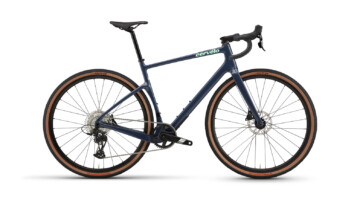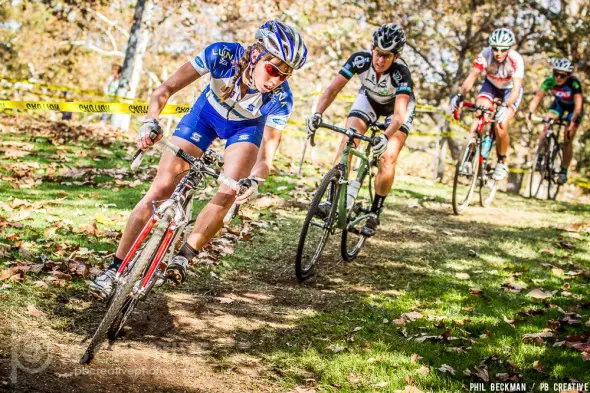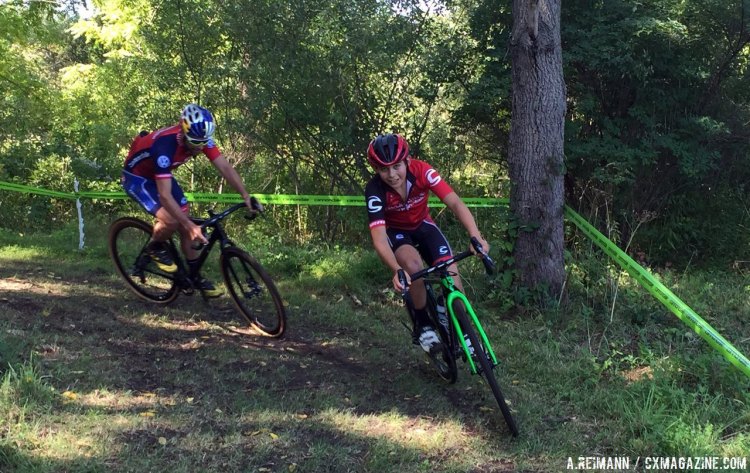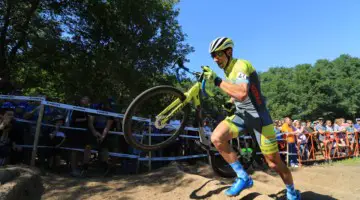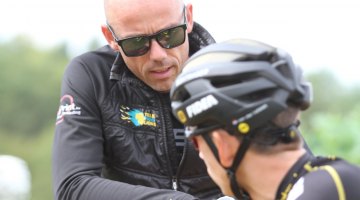Originally appearing in Cyclocross Magazine Issue 30, this week’s Technique Tuesday provides a detailed view about how to descend like a pro on the cyclocross course.
Written by Kenneth Lundgren, CEO and head coach of Elite Endurance Training Systems, these tips will have you finding your own moment of #Svenness. Read Lundgren’s advice and take the tips to heart during training or pre-riding the course while warming up for your race.
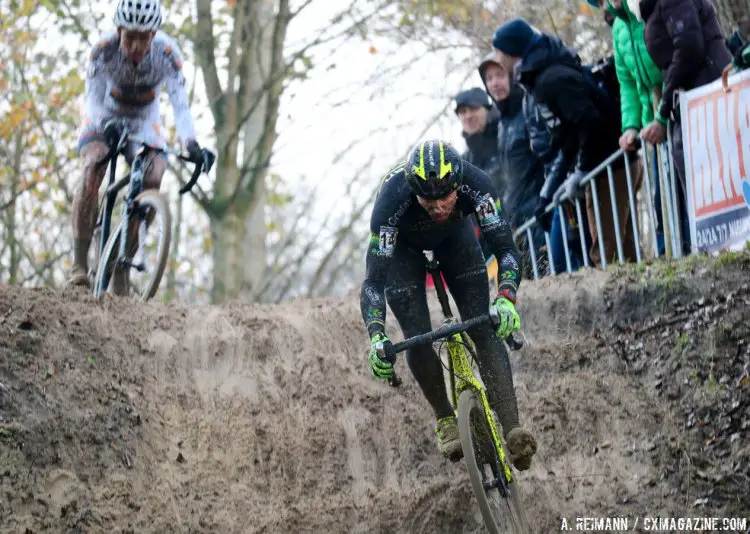
Follow these tips, and the next thing you know, you’ll be descending like Sven Nys. © A. Reimann / Cyclocross Magazine
The margins among average, good and great performances are very slim.
In cyclocross, the best riders usually are superior in two critical departments: power and bike-handling. You must work on both to ensure that you don’t have a severe weakness limiting you on any cyclocross course.
One glaring weak point for many cyclocross racers is their inability to ride descents with speed, both efficiently and confidently. Riders can gain free speed, and we are offering a few solid tips on how to improve your performance on the various forms of downhill you will encounter.
The Cyclocross Bike Fit
The cyclocross racer should be on the brake hoods 95 percent of the time, in training and in competition.
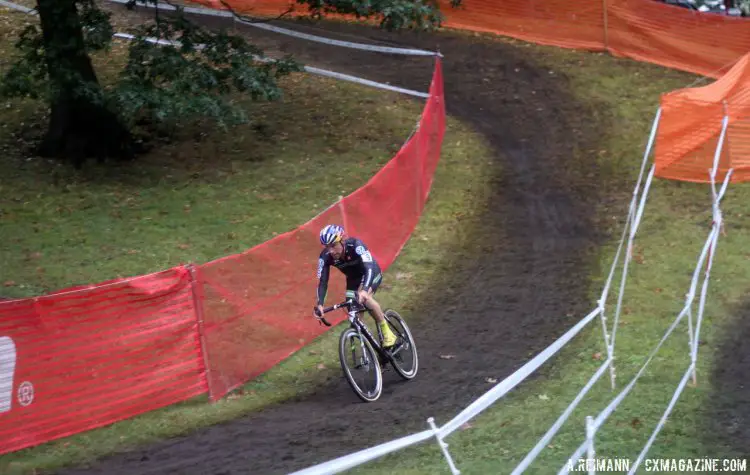
Bike fit varies person-to-person, but a trained fitter will have you sitting pretty like Tim Johnson, ready to tackle technical cyclocross descents. © Andrew Reimann
The cyclocross bike looks like a road bike, but it should be set up like a mountain bike. Tim Johnson is one of the nation’s top bike-handlers on the professional cyclocross circuit, and his bike looks like an extension of his body when he’s flowing through the course. His saddle is setback and his reach to the bars is comfortable; his hips are more upright and open. The brake hoods are close and the same height as his hips—the bicycle is set up purely for maximum power and bike-handling. His body weight is completely balanced and with the brake hoods upturned, he can keep a very loose grip on the bars, which is the critical ability.
Many riders cannot excel in the technical aspect of cyclocross performance because his/her bike fit is a major limiter.
Downhills with Sweeping Turns
It may sound obvious, but a key to riding downhills is to never go too fast, yet never go too slow–always feel in control. With more experience, your controlled speed will be faster and faster. Your hands are on the hoods. If there is a turn, get the majority of your braking done prior to the turn, as it can be hard to turn and maneuver when you are applying the brakes.
With the downhill turn, set up wide and early, aiming to use all of the tape—touch the outside tape as you line up, then come in tight to the inside tape as you apex the turn, then come out as wide again as you can, to maximize speed and make the turn as straight as possible. Stay relaxed and be confident, lead into the turn with your head—in order to achieve big speed, you need to see the big picture, so eyes up head up, look to where you want to go. Feather the brakes if necessary to maintain control. On these turns, traction isn’t a huge issue, so overall speed is based more on your comfort level, not skill level. Through the turn, keep your weight on the inside hand and outside foot, which will help the bicycle track through the turn naturally with less effort.
For challenging cyclocross turns, point your inside knee into the turn; the body English will help pull you through the turn while also rotating your hips where the bicycle needs to go—when you turn the hips, the bicycle will come around with it.
Simple Downhills, Tighter Turns
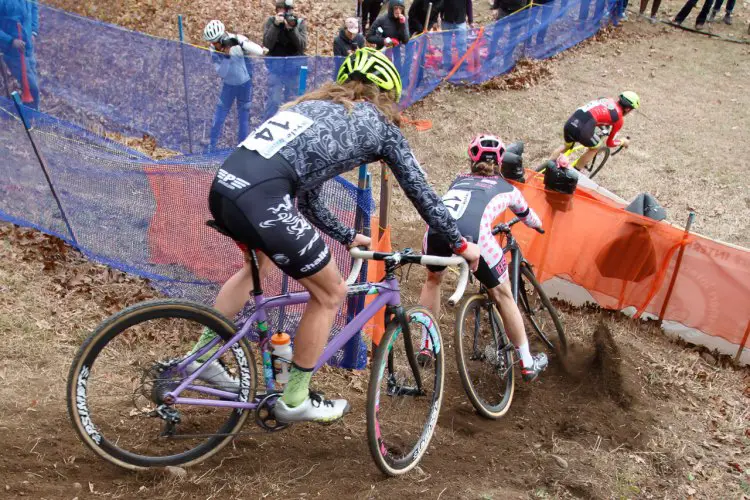
Anthony Clark shows how to get his weight back on the pro-only descent at the Cycle-Smart Northhampton International. Photo by Todd Prekaski
Your hands should be on the hoods. If the turn is tight, scoot to the back of the saddle, tightening the bicycle’s turning radius. Lead into the turn and control the bicycle with your hips—imagine you have a flashlight in your belly button, point that light where you want to go. Your hips will both control and help turn the bicycle. Your body weight is firmly on the outside foot and inside hand if you are seated through the turn.
If you have to stand at some point, always stand with wide elbows and wide knees, a stable stance to attack any technical section. You will feel like you are hugging a barrel—this will help with balance and also keep the bike freely moving under you, making the turn a far easier and natural movement.
Technical Downhills, Fast Turns
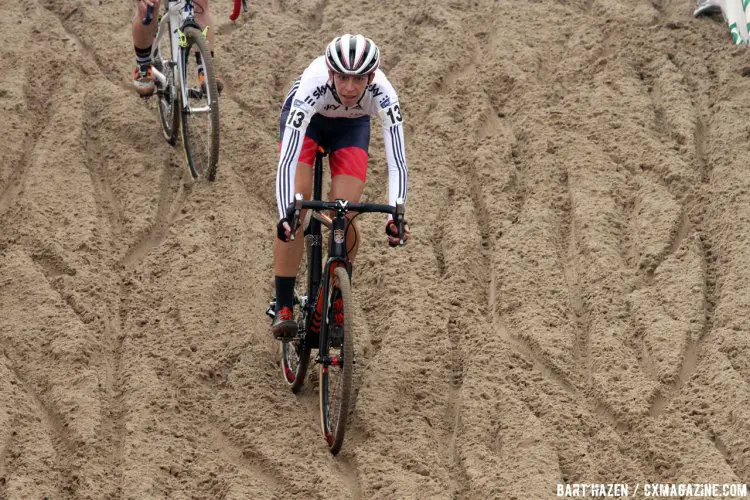
There’s not much more technical than a downhill sand chute. Helen Wyman gets into the drops and gets her weight back to handle it at the European Cyclocross Championships. © Bart Hazen
If the descent is beginning to get very steep and gnarly, opt to get in the drops, as it’s easier to both grip the bar and pull on the brakes. Some riders preferto stay on the hoods; this is a personal choice, but in truth, only the most-skilled riders tend to use the hoods on steeper downhills.
On the steepest pitches, your weight should be off the saddle and the bike kept in front of you to feel your weight on the rear wheel. On this steeper terrain, you are fighting gravity, which means traction will be decreased. The challenge is to not get nervous or tense. Many times when riders grab brakes on these sections, the tires break loose. Keep your speed steady and consistent, and the overall speed you achieve is based on traction, skill-level, and confidence. This means having tire selection and tire pressure dialed for each course. When many small things are done right, you will be surprised how much traction is available.
On gnarly downhills, try pushing your inside hand forward, not necessarily down—the extra countersteering will allow the bicycle to rotate naturally with more grip into the turn and through the turn. You and the bicycle are completely balanced and all you have to do is roll the turn at comfortable speed with your superior race line—trust yourself.
Off-Camber Downhills
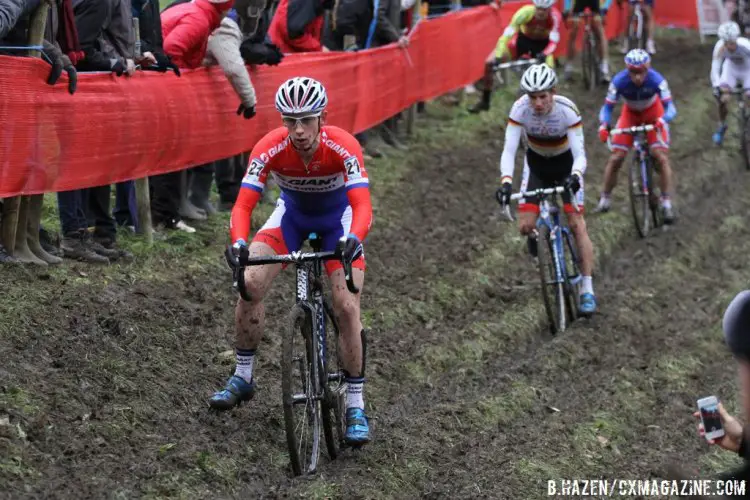
If traction is limited on an off-camber descent, a tripod will balance your body weight, as Lars van der Haar demonstrates. © Bart Hazen/Cyclocross Magazine
For most cases, start high on the hill— this will allow you a place to go if you falter—you can slide down the hill as youmake your way across. The exception is if there is a crystal clear fast line at bottom or if there is a clean rut on the low line, then you start and stay low.
On off-camber, keep your hands on the hoods so you can keep your body weight 100 percent balanced. Remain seated and feel your weight on the outside foot to gain maximum traction. Drive your outside foot down into the ground, feel this.
If traction is severely limited, tripod uphill/inside foot to gain more leverage and keep your body weight more balanced. With the inside foot out of the pedal operating as an outrigger, it can also help catch a slip or a fall.
The biggest key to off-camber terrain is to remain 100 percent plumb—do not lean into the hill. The slower you go, the more you can separate bike and body and use more body English to remain balanced.
The faster the speeds, the more you can to keep bike and body together and aligned, operating as one unit.
When the terrain is bumpy, you want to stay very relaxed on the bike—for many riders, if the bike is set up properly, grabbing the drops can be easier than the hoods. On the hoods, you must grab the hoods or your hand will slide off—in many cases, this makes the upper-body far too stiff, thus slowing potential velocity.
For many riders, getting into the drops is easier because you can rest and relax your hands. As Tim Johnson would say, if hoods are set up appropriately, you can ride the hoods on this terrain.
When the terrain gets really loose, bumpy, slick, when life gets technical for the cyclocross racer, you must not keep your arms and legs stiff—the bike will bounce, the tires will lose grip. Soft grip on the bars, keep your elbows and knees out (do not bend your elbows like Ls — flare your elbows out, so you are a shock-absorber, the bicycle will move in free, natural manner). Remain relaxed.
Training and Racing
When you are training alone in the park, or when you are pre-riding, the biggest key is to keep challenging yourself, and this means to always push out of your comfort zones. On technical terrain, take your tried and true lines, but also try different lines. Ride the well-established line, but then explore one or two variations. Always look for areas of traction and put your wheels on them. As you pre-ride, try to foresee areas where perhaps you can make up time in traffic.
On downhills, keys are to remain loose, relaxed, balanced. If you ride like this always, bombing descents at your full potential won’t seem like a shock. What you do in training you will do in racing, so get going. It’s all downhill from here.
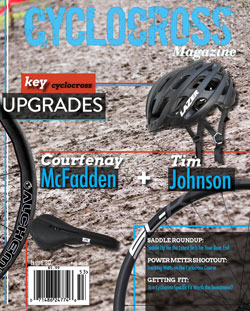 How to tackle descents in cyclocross was originally published in Cyclocross Magazine Issue 30, which also features a showcase on Courtenay McFadden, an interview with Tim Johnson, reviews about the best helmets for cyclocross, a saddle shootout, an in-depth look if getting a cyclocross-specific bike fit is a worthwhile investment and much, much more.
How to tackle descents in cyclocross was originally published in Cyclocross Magazine Issue 30, which also features a showcase on Courtenay McFadden, an interview with Tim Johnson, reviews about the best helmets for cyclocross, a saddle shootout, an in-depth look if getting a cyclocross-specific bike fit is a worthwhile investment and much, much more.
Want more in-depth cyclocross interviews and feature stories?
Be sure to subscribe to Cyclocross Magazine. We offer quarterly print subscriptions and a digital all-access subscription that gives you 24/7 access to Cyclocross Magazine’s current issue and our library of back copies.

